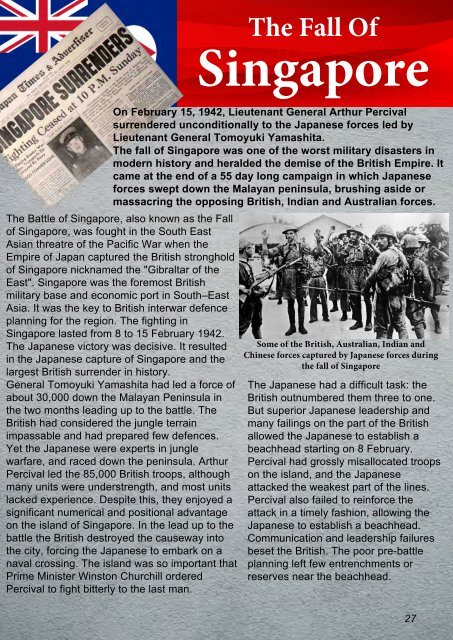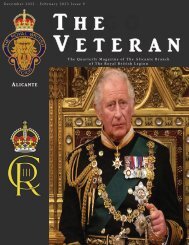The Veteran Issue 5
The Quarterly Magazine of the Alicante Branch of the Royal British Legion
The Quarterly Magazine of the Alicante Branch of the Royal British Legion
You also want an ePaper? Increase the reach of your titles
YUMPU automatically turns print PDFs into web optimized ePapers that Google loves.
<strong>The</strong> Fall Of<br />
Singapore<br />
On February 15, 1942, Lieutenant General Arthur Percival<br />
surrendered unconditionally to the Japanese forces led by<br />
Lieutenant General Tomoyuki Yamashita.<br />
<strong>The</strong> fall of Singapore was one of the worst military disasters in<br />
modern history and heralded the demise of the British Empire. It<br />
came at the end of a 55 day long campaign in which Japanese<br />
forces swept down the Malayan peninsula, brushing aside or<br />
massacring the opposing British, Indian and Australian forces.<br />
<strong>The</strong> Battle of Singapore, also known as the Fall<br />
of Singapore, was fought in the South East<br />
Asian threatre of the Pacific War when the<br />
Empire of Japan captured the British stronghold<br />
of Singapore nicknamed the "Gibraltar of the<br />
East". Singapore was the foremost British<br />
military base and economic port in South–East<br />
Asia. It was the key to British interwar defence<br />
planning for the region. <strong>The</strong> fighting in<br />
Singapore lasted from 8 to 15 February 1942.<br />
<strong>The</strong> Japanese victory was decisive. It resulted<br />
in the Japanese capture of Singapore and the<br />
largest British surrender in history.<br />
General Tomoyuki Yamashita had led a force of<br />
about 30,000 down the Malayan Peninsula in<br />
the two months leading up to the battle. <strong>The</strong><br />
British had considered the jungle terrain<br />
impassable and had prepared few defences.<br />
Yet the Japanese were experts in jungle<br />
warfare, and raced down the peninsula. Arthur<br />
Percival led the 85,000 British troops, although<br />
many units were understrength, and most units<br />
lacked experience. Despite this, they enjoyed a<br />
significant numerical and positional advantage<br />
on the island of Singapore. In the lead up to the<br />
battle the British destroyed the causeway into<br />
the city, forcing the Japanese to embark on a<br />
naval crossing. <strong>The</strong> island was so important that<br />
Prime Minister Winston Churchill ordered<br />
Percival to fight bitterly to the last man.<br />
Some of the British, Australian, Indian and<br />
Chinese forces captured by Japanese forces during<br />
the fall of Singapore<br />
<strong>The</strong> Japanese had a difficult task: the<br />
British outnumbered them three to one.<br />
But superior Japanese leadership and<br />
many failings on the part of the British<br />
allowed the Japanese to establish a<br />
beachhead starting on 8 February.<br />
Percival had grossly misallocated troops<br />
on the island, and the Japanese<br />
attacked the weakest part of the lines.<br />
Percival also failed to reinforce the<br />
attack in a timely fashion, allowing the<br />
Japanese to establish a beachhead.<br />
Communication and leadership failures<br />
beset the British. <strong>The</strong> poor pre-battle<br />
planning left few entrenchments or<br />
reserves near the beachhead.<br />
27











